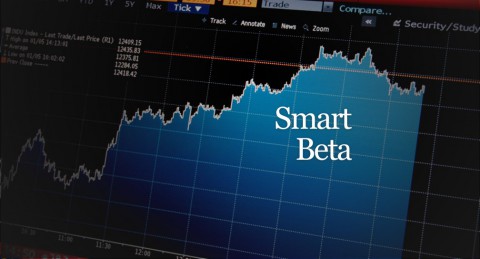- Smart beta strategies aim to improve returns, lower risk and increase diversification through a transparent, rules-based approach.
- Smart beta is the middle ground between active and passive management.
- Smart beta can offer low-cost exposure to one or several different investment factors including value, momentum, low-volatility, quality or size.
In recent years ‘Smart beta’ has become a hot topic within the investment industry. According to ETFGI, smart beta ETFs listed globally gathered $53.7 billion in the first ten months of 2015. Smart beta strategies are rapidly gaining traction among investors as the concept becomes more popular and more data becomes available regarding the performance of new funds and indices. Konrad Sippel, Global Head of Business Development at STOXX, has predicted that “by 2020, around 30 per cent of investor assets will be in smart beta products.”
Smart beta can’t be ignored. But what exactly is it? ‘Smart beta’ is something of a buzzword and most investment experts hate the term – suggested alternatives include Goldman Sachs’ ‘ActiveBeta’ or Morningstar’s ‘strategic beta’. Whatever the name – should you believe the hype?
What is it?
ETFs, or exchange traded funds, passively track a traditional market capitalisation index, such as the FTSE 100 or the S&P 500. The SPDR S&P 500 is the world’s largest ETF and its holdings replicate the weighting of each stock in the index – so the larger companies have a larger share and vice versa.
Smart beta on the other hand refers to alternative index strategies that weight stocks according to strategies or factors such as value or momentum that have a proven track record of beating the market. These strategies aim to improve returns, lower risk and increase diversification through a transparent, rules-based approach.
Active vs Passive
Smart beta is the middle ground between active and passive management. If a mutual fund is a tailored suit especially made for you, an ETF is a standard off the peg design. Smart beta on the other hand is an off the peg design that has been customized to fit you.
Alpha describes the returns that skilled active management can generate compared to relevant indexes, whilst beta is the term for returns derived from the market as a whole. Fund managers charge high fees in exchange for the promise of alpha, however research has shown that the majority of fund managers actually underperform benchmarks. ETFs have been accused of eating the lunch of traditional active management, as they offer a low-cost, transparent and tax efficient alternative.
As the happy medium between active and passive, Smart beta funds offer the low fees of a passive fund but with an active element that promises the higher returns usually associated with active management.
Why Smart beta?
Nobel-prize winning economist Bill Sharpe declared that the term ‘Smart beta’ makes him “definitionally sick”. The ‘smart’ moniker implies that traditional index strategies are dumb. This is clearly not the case; however, cap-weighted indices do have flaws. They tend to become skewed towards the higher value companies in the index, making the fund more sensitive to the performance of these stocks.
Smart beta strategies avoid this pitfall by systematically exploiting market trends and inefficiencies. Though usually slightly more expensive than cap-weighted ETFs, Smart beta funds are considerably cheaper than active management. Competitive pricing means that Goldman Sachs are charging just 9 basis points for their ActiveBeta U.S. Large Cap Equity ETF, launched in September 2015. According to Goldman Sachs, the industry average for Smart beta ETFs is 38 basis points.
Although factor based investing is nothing new, Smart beta can offer low-cost exposure to one or several different investment factors including value, momentum, low-volatility, quality or size. Investors can optimize their portfolio and tailor their exposure to these factors in order to reduce risk and generate returns.
What to pick
So which strategy is best? As Smart beta ETFs are multiplying, products with increasingly complicated strategies are available. Sometimes it’s best to keep it simple though. Some of the most popular Smart beta ETFs are minimum volatility, dividend or growth weighted. One factor with a consistently strong track record is momentum – the tendency for relative winning assets to continue winning, whilst relative losers keep losing. Companies including iShares by Blackrock, the world’s largest provider of ETFs, have issued special momentum-based ETFs.
50% of UK asset managers believe multi-factor smart beta products will see the biggest sales over the next year, according to a mid-2015 survey conducted by asset management research firm Cerulli. Goldman Sachs’ ActiveBeta ETFs acquire stocks based on good value, strong momentum, high quality and low volatility. A multi factor approach can help weather volatility in the market and reduce risk.
Investors looking to dabble in Smart beta should look closely at expected returns and fees as well as what factors the fund offers exposure to. There’s a lot of choice on the market and the key is to pick the smartest strategy – the right smart beta ETF can be a powerful tool.
